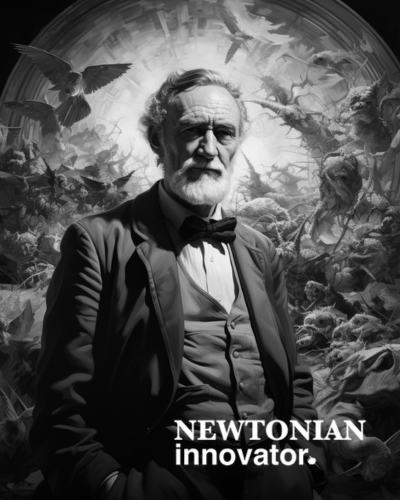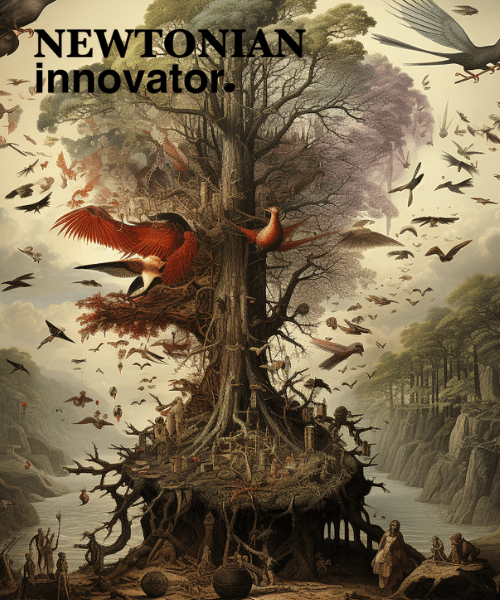Charles Darwin, a naturalist in the 19th century, sought to explain the diversity of life on Earth and why certain traits or adaptations are more prevalent in some species than others. This led him to conceive of a “tree of life” where all organisms are descended and branched off from common ancestors over countless generations. Through a thought experiment, Darwin theorized that species gradually evolve and adapt to their environments over time through a process he called “natural selection.”
Charles Darwin was born in 1809 in Shrewsbury, England to a wealthy family. His father was a doctor and hoped Darwin would follow in his footsteps. However, Darwin was an avid naturalist from a young age as he collected specimens while observing wildlife. Although he studied theology at Cambridge University with the intention of becoming a clergyman, as his father wished, Darwin’s true passion lay in science and natural history. After graduating in 1831, Darwin joined a five-year scientific expedition on the survey ship HMS Beagle. This voyage around the world, especially his observations in the Galapagos Islands, solidified Darwin’s interest in speciation and the origins of life.

When Darwin returned to England in 1836, he gained some recognition as a geologist and naturalist. He married Emma Wedgwood in 1839, with whom he would have ten children. Most of his scientific work was conducted at his home in Downe, Kent. Due to recurring illness, likely Chagas disease contracted during his voyage, he was often bedridden. Darwin lived a relatively quiet life focused on his research, corresponding with other scientists, and spending time with his family. He died in 1882 and was buried in Westminster Abbey, honored for his contributions to science. Despite controversy, his evolutionary theory profoundly shaped our understanding of the natural world.
Darwin’s thought experiment of imagining a branching effect that represented evolutionary descent was critical in the development of his theory of natural selection. During his voyage on the Beagle, Darwin observed patterns in nature that led him to question the accepted views of the time regarding the origin of species. Darwin’s concept of a branching tree symbolized the interconnectedness of life he observed during his travels, suggesting all life is related, like branches extending from a single trunk.
This concept of natural selection provided Darwin with a framework to understand evolution’s mechanics. Darwin proposed that as organisms reproduce, they undergo random variations. Those with variations better adapted to their environment have a higher chance of survival and reproduction. Over time, these beneficial traits become prevalent in populations, while less advantageous ones diminish. It’s the environment that steers life’s evolution, favoring traits that enhance survival and reproduction. The ever-diversifying tree of life emerges from these incremental changes over generations, rather than from the idea of a spontaneous divine creation of unchanging species.
It’s crucial to differentiate between evolution and natural selection, terms often used interchangeably, but which refer to distinct biological concepts and the nuances of how species change over time.
Evolution refers to the change in the characteristics of a species over several generations. It encompasses the entire process by which species undergo transformation over time, leading to the diversity of organisms we see today. This change can be observed in physical characteristics, genetic sequences, or behaviors. For instance, the fossil record shows a clear progression of species from simpler forms to more complex ones over billions of years.
Natural selection is a mechanism or process by which evolution can occur. It’s the idea that individuals with traits better suited to their environment are more likely to survive and reproduce. Over time, these advantageous traits become more common in the population. On the other hand, traits that are disadvantageous in a particular environment tend to decrease in frequency.
Take for example the giraffe’s neck, it’s a misconception to think that giraffes stretched their necks to reach higher branches and thus their necks grew longer. Instead, it’s more likely that over many generations, giraffes with naturally longer necks had an advantage. They could access food sources that shorter-necked giraffes couldn’t, and perhaps they had a better vantage point to spot predators. These longer-necked giraffes were more likely to survive and reproduce, passing on their long-neck genes to the next generation. Over time, the population of giraffes shifted to having predominantly longer necks.
Although Darwin began formulating his ideas in 1837, it took over 20 years of research, breeding experiments, and correspondence with other scientists before he published ‘On the Origin of Species’ in 1859. For example, he studied animal breeding to better understand heritability and variation. He examined fossils, such as transitional forms with ancestral traits, that reflected gradual change over geologic time. He observed biogeography and how related species inhabited neighboring isolated areas like islands and continents. Throughout, Darwin continued to correspond extensively with fellow scientists to refine his ideas.
In 1858, spurred by a letter from Alfred Russel Wallace who had independently derived a similar theory, Darwin began compiling his work into ‘On the Origin of Species.’ When finally published, the book outlined Darwin’s groundbreaking, though controversial, theory of evolution by natural selection that stands today to be scientifically sound.

Scientists inspired by Darwin have uncovered extensive evidence filling in details about how natural selection operates and the evolutionary relationships among organisms. Darwin’s thought process also influenced other disciplines by showing that observations in nature could lead to fundamental scientific advances. His rigorous collection and examination of observed evidence across geology, zoology, botany, and paleontology was an exemplar of the scientific method.
Darwin’s willingness to question established ideas and think unconventionally paved the way for the field of evolutionary biology. He demonstrated the immense power of conceptualizing theoretical models to guide research and uncover new insights about the natural world. His thought experiment envisioned a process driving the evolution of life that was later supported by genetics, population studies, and the fossil record. Darwin showed how following scientific evidence where it leads, even if it challenges existing ideas, can profoundly reshape human knowledge. His influence on future scientists underscores the importance of creatively synthesizing concepts to explain the natural world based on systematic observations, experiments, and data.
Let Darwin’s thought experiment be a reminder that transformational science can begin with a simple sketch and an open mind. New breakthroughs are often built on small conceptual seeds planted through observation and imagination. Do not be afraid to question established ideas if evidence leads you somewhere new. There are always fresh discoveries waiting for those who creatively synthesize what they see in nature into testable ideas. The next revolutionary theories may come from your own notebooks if you envision and follow where potential leads. Keep thinking, observing, testing, and asking what if? This is how we expand knowledge of the natural world and beyond, the interconnectedness branching out from Earth into our solar system and ultimately into depths of the unknown corners of our universe.






